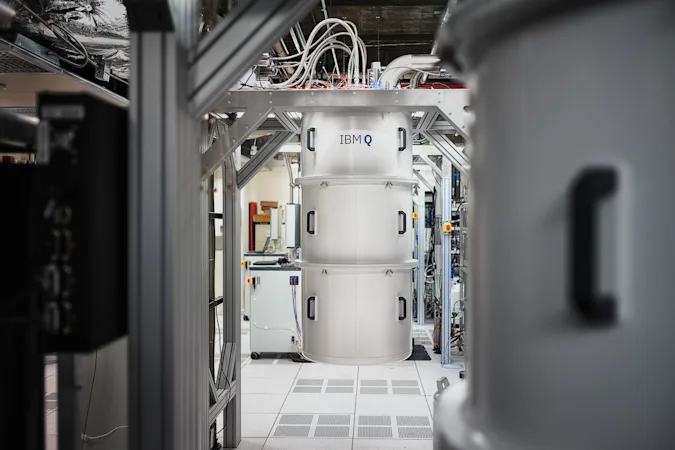
PRESS RELEASE — IBM (NYSE: IBM) today announced the expansion of its roadmap for achieving large-scale, practical quantum computing. The company plans for new modular architectures and networking that will allow its quantum systems to have larger qubit-counts – up to hundreds of thousands of qubits. To enable them with the speed and quality necessary for practical quantum computing, the qubits will be orchestrated by an increasingly intelligent software layer to efficiently distribute workloads and abstract away infrastructure challenges.
IBM’s work to usher in an era of practical quantum computing is dependent on three pillars: robust and scalable quantum hardware; cutting-edge quantum software to orchestrate and enable accessible and powerful quantum programs; and a broad global ecosystem of quantum-ready organizations and communities.
“In just two years, our team has made incredible progress on our existing quantum roadmap. Executing on our vision has given us clear visibility into the future of quantum and what it will take to get us to the practical quantum computing era,” said Dario Gil, Senior Vice President, Director of Research, IBM. “With quantum serverless operations and the advances in hardware, software, and theory outlined in our roadmap, we will usher in an era of quantum-centric supercomputers that will open up large and powerful computational spaces for our partners and clients.”
IBM originally announced its quantum roadmap in 2020. Since then, the company has delivered on each of the targets on its timeline. This includes ‘Eagle’, a 127-qubit processor with quantum circuits that cannot be reliably simulated exactly on a classical computer, and whose architecture laid the groundwork for processors with increasingly more qubits. Additionally, IBM has delivered a 120x speedup in quantum runtimes delivered via the Qiskit Runtime software platform. Later this year, IBM expects to continue the previously laid out targets on its roadmap and unveil its 433-qubit processor, Osprey.

In 2023, IBM will progress its goals to build a frictionless development experience with Qiskit Runtime and workflows built right in the cloud — bringing a serverless approach into the core quantum software stack and giving developers advanced simplicity and flexibility. This serverless approach will also mark a critical step in achieving the intelligent and efficient distribution of problems across quantum and classical systems. On the hardware front, IBM will introduce Condor, the world’s first universal quantum processor with over 1,000 qubits.
Introducing Modular Quantum Computing
With this new roadmap, IBM is targeting three regimes of scalability for its quantum processors.
The first requires building capabilities to classically communicate and parallelize operations across multiple processors. This opens the avenue to a broader set of techniques necessary for practical quantum systems, such as improved error mitigation techniques and intelligent workload orchestration, by combining classical compute resources with quantum processors that can extend in size.
The next step in delivering scalable architecture will deploy short-range, chip-level couplers. These couplers will closely connect multiple chips together to effectively form a single and larger processor, and will introduce fundamental modularity that is key to scaling.
The third component to reaching true scalability will be to provide quantum communication links between quantum processors. To do so, IBM has proposed quantum communication links to connect clusters together into a larger quantum system.
All three of these scalability techniques will be combined to reach IBM’s 2025 goal: a 4,000+ qubit processor built with multiple clusters of modularly scaled processors.
Building the Fabric of Quantum-Centric Supercomputing
In tandem with hardware breakthroughs, IBM’s roadmap targets software milestones to improve error suppression and mitigation. These techniques are currently progressing the ability of quantum software to minimize the effect of noise on the users’ application and are paving the path towards the error-corrected quantum systems of the future.
Earlier this year, IBM launched ready-made primitive programs to minimize infrastructure requirements and allow developers to access and build larger quantum programs more easily. In 2023, IBM plans to expand these primitives, with capabilities that allow developers to run them on parallelized quantum processors there by speeding up the user’s application.
These primitives will fuel IBM’s target to deliver Quantum Serverless into its core software stack in 2023, which will enable developers to easily tap into flexible quantum and classical resources. Quantum Serverless will also lay the groundwork for core functionality within IBM’s software stack to intelligently trade off and switch between elastic classical and quantum resources; forming the fabric of quantum-centric supercomputing.
The new systems targeted on IBM’s expanded quantum roadmap will be designed to work within IBM Quantum System Two. Incorporating modularity and flexibility into every layer of the technology stack, IBM Quantum System Two will offer the infrastructure needed to successfully link together multiple quantum processors. The prototype of this system is expected to be up and running in 2023.
For more market insights, check out our latest quantum computing news here.


















